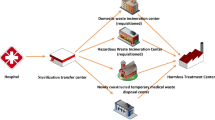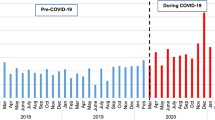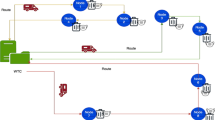Abstract
During the COVID-19 pandemic, disposable masks, protective clothing, gloves, and nasopharyngeal swabs collected by nucleic acid testing formed a large amount of medical waste. Medical waste has strict temporary storage time requirements in hospitals, which need to be transported to medical waste disposal plants within the specified time. However, as most of disposal plants are far away from downtown, they also need to be responsible for the transportation and disposal of medical waste in many hospitals, and put forward higher requirement for transportation routes. Rapid and safe disposal of all types of medical waste generated by COVID-19 is crucial to the prevention and control of the epidemic. This paper designs the transportation route optimization model using Anylogic simulation software based on the regional distribution of 118 tertiary hospitals and 2 large medical waste disposal plants in Beijing, China. At the same time, transportation routes of 118 tertiary hospitals in the morning peak, evening peak, all-day, and ordinary periods were simulated based on the Beijing traffic index in 2017. On this basis, through the analysis of the simulation data, the selection of medical waste transport routes for 118 tertiary hospitals in the morning peak, evening peak, all day, and ordinary periods is further clarified, so as to ensure that medical waste can be transported to the medical waste disposal plant in the shortest time. The shortest path and fastest speed transport mode, medical waste transport data set, and the selection of transport mode of 118 tertiary hospitals formed by this research provide certain reference experience for the rapid and safe transport of medical waste during the epidemic period, and also provides corresponding data support for medical waste transportation management in the post-epidemic era and medical waste transportation decision-making when facing major public health problems.





Similar content being viewed by others
Data availability
The data and materials of this study are available within the article.
References
Akhtar M, Hannan MA, Begum RA, Basri H, Scavino E (2017) Backtracking search algorithm in CVRP models for efficient solid waste collection and route optimization. Waste Manage 61:117–128
Ardakani MK, Tavana M (2015) A decremental approach with the A∗ algorithm for speeding-up the optimization process in dynamic shortest path problems. Measurement 60:299–307
Babaee Tirkolaee E, Aydın NS (2021) A sustainable medical waste collection and transportation model for pandemics. Waste Manag Res 39(1_suppl):34–44
Beijing Municipal Commission of Health and Family Planning (2018) Beijing municipal health and family planning development statistical bulletin in 2017. Available at: http://www.phic.org.cn/tjsj/. Accessed 26 Oct 2023
Beijing Municipal Environmental Protection Bureau (2017) List of units holding the hazardous waste management license in Beijing. Available at: https://sthjj.beijing.gov.cn/. Accessed 26 Oct 2023
Cao C, Li J, Liu J, Liu J, Qiu H, Zhen J (2022) Sustainable development-oriented location-transportation integrated optimization problem regarding multi-period multi-type disaster medical waste during COVID-19 pandemic. Ann Oper Res. https://doi.org/10.1007/s10479-022-04820-2
Chen C, Chen J, Fang R, Ye F, Yang Z, Wang Z, …Tan W (2021) What medical waste management system may cope With COVID-19 pandemic: lessons from Wuhan. Resour Conserv Recycl 170:105600
Das S, Bhattacharyya BK (2015) Optimization of municipal solid waste collection and transportation routes. Waste Manage 43:9–18
Demiryurek U, Banaei-Kashani F, Shahabi C (2010) A case for time-dependent shortest path computation in spatial networks. In Proceedings of the 18th SIGSPATIAL International Conference on Advances in Geographic Information Systems. ACM. 474–477
Deng Y, Chen Y, Zhang Y, Mahadevan S (2012) Fuzzy Dijkstra algorithm for shortest path problem under uncertain environment. Appl Soft Comput 12(3):1231–1237
Dou GQ, Zhu YS, Han YM (2011) Shortest path algorithm based on city emergency system. 2011 IEEE International Conference on Advanced Mechatronic Systems (ICAMechS) Zhengzhou, China. 270–272
Dwivedi N, Sharma H, Shanker S, Barve A (2022) Third-party logistics in bio-medical waste system: a path towards a risk-free sector. Process Integr Optim Sustain 6(4):1075–1102
Erden T, Coskun MZ (2005) Analyzing shortest and fastest speed with GIS and determining algorithm running time. International Conference on Advances in Visual Information Systems. Springer, Berlin, pp 269–278
Eren E, Tuzkaya UR (2021) Safe distance-based vehicle routing problem: medical waste collection case study in COVID-19 pandemic. Comput Ind Eng 157:107328
Gaode map (2018) 2017 China’s major cities public transport big data analysis report, Gaode map traffic big data. Available at: http://report.amap.com/share.do?id=8a38bb866326d88601634df004011033. Accessed 26 Oct 2023
Govindan K, Nasr AK, Mostafazadeh P, Mina H (2021) Medical waste management during coronavirus disease 2019 (COVID-19) outbreak: a mathematical programming model. Comput Ind Eng 162:107668
Ibrahim RS, Rusdiansyah A (2021) Age-dependent inventory routing problem model for medical waste collection. Proceedings of the Second Asia Pacific International Conference on Industrial Engineering and Operations Management. Surakarta, Indonesia, September 14–16, pp 2200–2209. http://ieomsociety.org/proceedings/2021indonesia/417.pdf. Accessed 26 Oct 2023
Idri A, Oukarfi M, Boulmakoul A, Zeitouni K, Masri A (2017) A new time-dependent shortest path algorithm for multimodal transportation network. Procedia Comput Sci 109:692–697
Kinobe JR, Bosona T, Gebresenbet G, Niwagaba CB, Vinnerås B (2015) Optimization of waste collection and disposal in Kampala city. Habitat Int 49:126–137
Lella J, Mandla VR, Zhu X (2017) Solid waste collection/transport optimization and vegetation land cover estimation using Geographic Information System (GIS): a case study of a proposed smart-city. Sustain Cities Soc 35:336–349
Liu Z, Li Z, Chen W, Zhao Y, Yue H, Wu Z (2020) Path optimization of medical waste transport routes in the emergent public health event of covid-19: a hybrid optimization algorithm based on the immune–ant colony algorithm. Int J Environ Res Public Health 17(16):5831
Mei X, Hao H, Sun Y, Wang X, Zhou Y (2022) Optimization of medical waste recycling network considering disposal capacity bottlenecks under a novel coronavirus pneumonia outbreak. Environ Sci Pollut Res 29(53):79669–79687
Ministry of Ecology and Environment, People’s Republic of China (2020) Management and technical guidelines for emergency treatment of medical waste in the case of pneumonia infected by COVID-19 (Trial). Available at: https://www.mee.gov.cn/ywdt/hjywnews/202001/t20200129_761043.shtml. Accessed 26 Oct 2023
National Health Commission of the People’s Republic of China. & Ministry of Ecology and Environment, People’s Republic of China (2021) Classification catalogue of medical waste (2021 Edition). Available at: http://www.nhc.gov.cn/yzygj/s7659/202111/a41b01037b1245d8bacf9acf2cd01c13.shtml. Accessed 26 Oct 2023
Nguyen-Trong K, Nguyen-Thi-Ngoc A, Nguyen-Ngoc D, Dinh-Thi-Hai V (2017) Optimization of municipal solid waste transportation by integrating GIS analysis, equation-based, and agent-based model. Waste Manage 59:14–22
Panahi S, Delavar MR (2008) A GIS-based dynamic shortest path determination in emergency vehicles. World Appl Sci J 3(1):88–94
Raut HV, Nagne AD, Kale KV (2015) Management of food waste by using GIS environment: a review. Int J Comput Sci Eng 3(7):144–151. https://www.ijcseonline.org/pub_paper/27-IJCSE-01179.pdf. Accessed 26 Oct 2023
Son LH, Louati A (2016) Modeling municipal solid waste collection: a generalized vehicle routing model with multiple transfer stations, gather sites and inhomogeneous vehicles in time windows. Waste Manage 52:34–49
State Council of the People's Republic of China (2003) Decree of the State Council of the People's Republic of China (No. 380), Regulations on the Administration of Medical Wastes. Available at: https://www.gov.cn/gongbao/content/2003/content_62236.htm. Accessed 26 Oct 2023
Sunita, Garg D (2021) Dynamizing Dijkstra: a solution to dynamic shortest path problem through retroactive priority queue. J King Saud Univ-Comput Inform Sci 33(3):364–373
Tang J, Liu X, Wang W (2023) COVID-19 medical waste transportation risk evaluation integrating type-2 fuzzy total interpretive structural modeling and Bayesian network. Expert Syst Appl 213:118885
Taslimi M, Batta R, Kwon C (2020) Medical waste collection considering transportation and storage risk. Comput Oper Res 120:104966
Tirkolaee EB, Abbasian P, Weber GW (2021) Sustainable fuzzy multi-trip location-routing problem for medical waste management during the COVID-19 outbreak. Sci Total Environ 756:143607
Vecchi TPB, Surco DF, Constantino AA, Steiner MTA, Jorge LMM, Ravagnani MASS, Paraíso PR (2016) A sequential approach for the optimization of truck routes for solid waste collection. Process Saf Environ Prot 102:238–250
Wang Q, Huang R (2021) The impact of COVID-19 pandemic on sustainable development goals–a survey. Environ Res 202:111637
Wang Q, Su M (2020) A preliminary assessment of the impact of COVID-19 on environment–a case study of China. Sci Total Environ 728:138915
Wang Q, Zhang F (2021) What does the China’s economic recovery after COVID-19 pandemic mean for the economic growth and energy consumption of other countries? J Clean Prod 295:126265
Wang Q, Yang X, Li R (2022a) The impact of the COVID-19 pandemic on the energy market–a comparative relationship between oil and coal. Energ Strat Rev 39:100761
Wang Q, Li S, Li R, Jiang F (2022b) Underestimated impact of the COVID-19 on carbon emission reduction in developing countries–a novel assessment based on scenario analysis. Environ Res 204:111990
Wang H, Zheng L, Xue Q, Li X (2022c) Research on medical waste supervision model and implementation method based on blockchain. Secur Commun Netw 5630960. https://doi.org/10.1155/2022/5630960
World Health Organization (2018) Health-care waste. Key facts[EB/OL], Available at: http://www.who.int/mediacentre/factsheets/fs253/en/
Xie DX, Zhu HB, Yan L, Yuan S, Zhang JQ (2012) An improved Dijkstra algorithm in GIS application. In World Automation Congress 2012 (WAC), IEEE, Puerto Vallarta, Mexico, 167–169. https://ieeexplore.ieee.org/abstract/document/6321059. Accessed 26 Oct 2023
Yu H, Sun X, Solvang WD, Zhao X (2020) Reverse logistics network design for effective management of medical waste in epidemic outbreaks: insights from the coronavirus disease 2019 (COVID-19) outbreak in Wuhan (China). Int J Environ Res Public Health 17(5):1770
Zeng W, Church RL (2009) Finding shortest paths on real road networks: the case for A. Int J Geogr Inf Sci 23(4):531–543
Zsigraiova Z, Semiao V, Beijoco F (2013) Operation costs and pollutant emissions reduction by definition of new collection scheduling and optimization of MSW collection routes using GIS. The case study of Barreiro, Portugal. Waste Manag 33(4):793–806
Acknowledgements
This work has been supported by the National Natural Science Foundation of China (grant no. 72274032), the Project funded by China Postdoctoral Science Foundation (grant no. 2022M710368), the Fundamental Research Funds for the Central Universities (grant nos. N2223033, N2223017, N2323015, and N2323016), the Humanities and Social Science Research Project of Hebei Education Department (grant no. BJ2021104), the Natural Science Foundation of Hebei Province (grant nos. G2021501012 and G2022501004), and the Social Science Foundation of Liaoning Province (grant no. L20BXW004).
Author information
Authors and Affiliations
Contributions
Dr. Hao Liu wrote the original draft, designed the technical model, collected and processed the data, and provided the material; Prof. Zhong Yao and Prof. Sebastiaan Meijer reviewed, revised, and edited the manuscript.
Corresponding author
Ethics declarations
Ethical approval
Not applicable.
Consent to participate
Not applicable.
Consent for publication
Not applicable.
Conflict of interest
The authors declare no competing interests.
Additional information
Responsible Editor: Philippe Garrigues
Publisher's Note
Springer Nature remains neutral with regard to jurisdictional claims in published maps and institutional affiliations.
Rights and permissions
Springer Nature or its licensor (e.g. a society or other partner) holds exclusive rights to this article under a publishing agreement with the author(s) or other rightsholder(s); author self-archiving of the accepted manuscript version of this article is solely governed by the terms of such publishing agreement and applicable law.
About this article
Cite this article
Liu, H., Yao, Z. & Meijer, S. Research on transportation management model of COVID-19 medical waste: a case study in Beijing, China. Environ Sci Pollut Res 30, 120284–120299 (2023). https://doi.org/10.1007/s11356-023-30605-6
Received:
Accepted:
Published:
Issue Date:
DOI: https://doi.org/10.1007/s11356-023-30605-6




